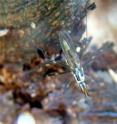Old before their time? Aging in flies under natural vs. laboratory conditions
Evolutionary studies of aging typically utilize small, short-lived animals (insects, worms, mice) under benign conditions – constant temperature and humidity, no parasites, superabundant food – in the laboratory. Oddly enough, very little is known about aging in such animals in their harsh, stressful natural environments. Could it be that these laboratory "guinea pigs" actually age much more slowly in captive luxury than do their wild cousins? Nori Kawasaki, Rob Brooks, and Russell Bonduriansky of the University of New South Wales, and Chad Brassil of the University of Nebraska, set out to find out, using the giant Australian stilt-legged fly Telostylinus angusticollis, a beautiful, sexually dimorphic animal that breeds on rotten wood. To identify individual flies in the wild, they wrote codes (combinations of Arabic numerals and Latin and Japanese letters) on the flies' backs using enamel paint, and recorded the comings and goings of marked individuals on Acacia trunks while simultaneously monitoring their captive cousins in the lab.
Analysis, published in the September issue of the American Naturalist, revealed striking contrasts between wild and captivity: in males, the rate of aging (measured as the rate of increase of mortality rate with age) was as least two-fold greater in the wild than in the laboratory. Curiously, wild females did not seem to age at all. For both sexes, life expectancies in the wild were dramatically shorter than in the lab.
Evolutionary biologists have long sought to understand how environmental factors generate natural selection on the rate of aging, and ultimately influence the frequencies of genes that underpin genetic variation in this trait. Much less is known about how environment affects the expression of genes that modulate aging rate. Kawasaki et al. have shown that animals can age much faster in their stressful natural environments than in the benign conditions of the laboratory. Their results suggest that laboratory estimates of aging and lifespan (and, therefore, fitness) should be interpreted with considerable caution.
Source: University of Chicago Press Journals
Other sources
- Old before their time? Aging in flies under natural vs. laboratory conditionsfrom Biology News NetMon, 8 Sep 2008, 22:21:19 UTC
- Old Before Their Time? Aging Rate In Flies Twice As Fast In Wild Than In Laboratoryfrom Science DailySun, 7 Sep 2008, 22:21:31 UTC
- Old Before Their Time? Aging In Flies Under Natural Vs. Laboratory Conditionsfrom Science DailyFri, 5 Sep 2008, 20:28:08 UTC
- Old before their time? Aging in flies under natural vs. laboratory conditionsfrom Biology News NetFri, 5 Sep 2008, 16:56:10 UTC
- Old before their time? Aging in flies under natural vs. laboratory conditionsfrom PhysorgFri, 5 Sep 2008, 15:14:19 UTC
